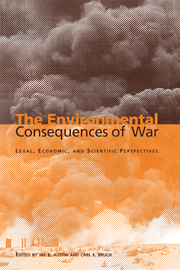Book contents
- Frontmatter
- Contents
- List of illustrations
- List of tables
- List of contributors
- Acknowledgements
- Foreword by Klaus Toepfer
- Introduction
- Part I General principles
- Part II The legal framework
- Part III Assessing the impacts – scientific methods and issues
- Part IV Valuing the impacts – economic methods and issues
- Part V Prospects for the future
- Introduction
- 22 Protecting specially important areas during international armed conflict: a critique of the IUCN Draft Convention on the Prohibition of Hostile Military Activities in Protected Areas
- 23 The Chemical Weapons Convention: a verification and enforcement model for determining legal responsibility for environmental harm caused by war
- 24 International legal mechanisms for determining liability for environmental damage under international humanitarian law
- 25 Waging war against the world: the need to move from war crimes to environmental crimes
- Epilogue
- Index
23 - The Chemical Weapons Convention: a verification and enforcement model for determining legal responsibility for environmental harm caused by war
Published online by Cambridge University Press: 04 August 2010
- Frontmatter
- Contents
- List of illustrations
- List of tables
- List of contributors
- Acknowledgements
- Foreword by Klaus Toepfer
- Introduction
- Part I General principles
- Part II The legal framework
- Part III Assessing the impacts – scientific methods and issues
- Part IV Valuing the impacts – economic methods and issues
- Part V Prospects for the future
- Introduction
- 22 Protecting specially important areas during international armed conflict: a critique of the IUCN Draft Convention on the Prohibition of Hostile Military Activities in Protected Areas
- 23 The Chemical Weapons Convention: a verification and enforcement model for determining legal responsibility for environmental harm caused by war
- 24 International legal mechanisms for determining liability for environmental damage under international humanitarian law
- 25 Waging war against the world: the need to move from war crimes to environmental crimes
- Epilogue
- Index
Summary
Introduction
When warfare was envisaged as Napoleonic battalions or German Panzer units traversing Europe, no serious conceptual difficulties attended the detection and identification of environmental consequences. Even in the modern era, battle scars inflicted by artillery and gunfire raise only trifling new problems in this regard. And when considering nuclear weapons, it is ironic that an exemplary virtue of their use would be the ease of detecting at least the direct environmental damage from their detonation.
But a more insidious form of warfare is moving into a preeminent role on the international stage: chemical and biological weapons (CBW). Chemical weapons may be defined primarily as nerve agents, which are closely related to toxins – inanimate poisonous substances produced by living organisms. Biological weapons may be defined as living organisms that infect their victims, causing incapacitation and often death; some can spread to other living entities, even those not initially attacked. Unlike ordnance, these weapons are dispersed as a difficult-to-detect aerosol; moreover, unlike ordnance, the injurious effects of these weapons typically linger far beyond their initial use. Measured by their capability to contaminate soil and water and hence despoil an ecosystem for a prolonged period, the environmental harms caused by CBW exceed the damage caused by most explosive munitions. In terms of assigning responsibility, the invisibility of chemical or biological agents, combined with their long-lasting and noxious effects, complicates the task of building a legal regime to assess those harms.
- Type
- Chapter
- Information
- The Environmental Consequences of WarLegal, Economic, and Scientific Perspectives, pp. 579 - 601Publisher: Cambridge University PressPrint publication year: 2000



